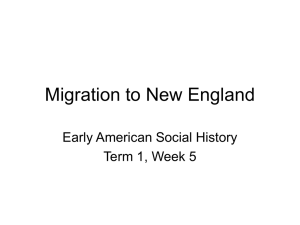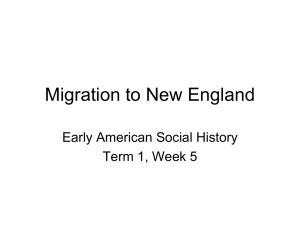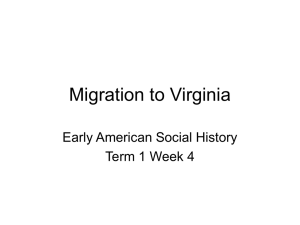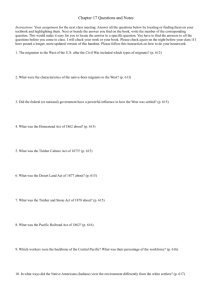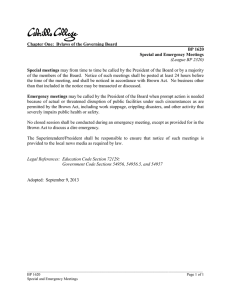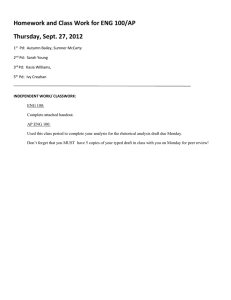Migration to Virginia and New England Early American Social History
advertisement
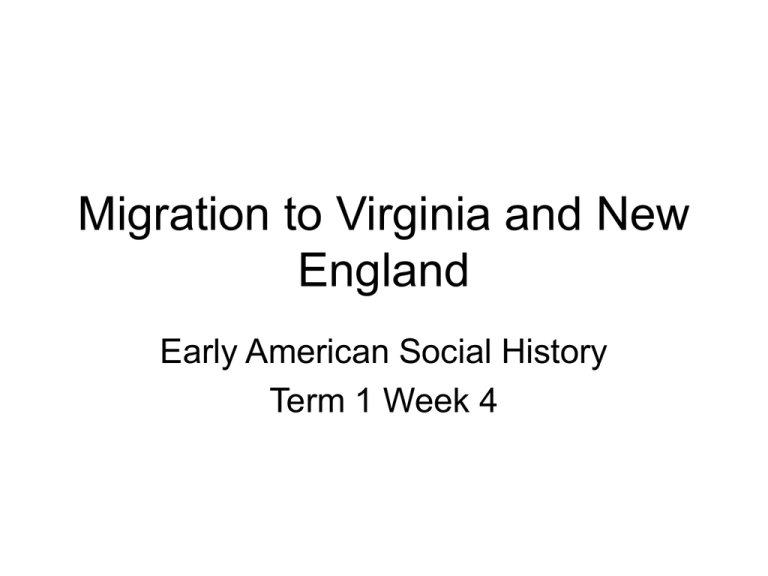
Migration to Virginia and New England Early American Social History Term 1 Week 4 After Roanoke • 20 year wait for colonisation to restart • Nothing possible until succession decided, too much uncertainty • James I (1603-25) ends war with Spain 1604. Ends profits from privateering • Forces reconsideration of colonisation • Importance of getting a charter, royal sanction/support, sets out claims, regardless of other powers • 1606 charters given to Virginia Company of London and Virginia Company of Plymouth to settle between 34 and 45 degrees N latitude, (NC to Maine) The Virginia Company (London) • Basically made up of merchants, charter talks of trade and bringing Xnty to natives.(c.f. Roanoke/ Hakluyt) • Needs colonists as traders, potential soldiers to defend vs Indians or Spanish • Offers free land for settlers; gets 144 young men to go on first voyage on board 3 ships (Godspeed, Discovery and Susan Constant) • Arrives Jamestown May 1607 James Fort Migrants 1 • All migrants before 1618 = male, most young (under 25) • Free land offered by Va Co obvious draw to poor, as well as to younger sons of gentry, i.e. those with little prospect of riches in Eng • Main motivation = economic, seeking fortune and status, many migrants see Va as temp home • Imp of indentured labour, sold for number of years in return for passage. Possibility of land at end of service. • Problems of flight, seen as form of slavery, main source of labour in Va before 1680 Migrants 2 • Campbell / Galenson debate over social status ‘middling people’ or ‘common sort’ ? • Problem of source materials, mainly from 1650s, incompleteness of data, need for interpretation. • Va migrants probably broadly reflected Eng popn, i.e. mainly poor (farmers, labourers, artisans), but not the truly destitute, and few merchants, aristocrats, or wealthy people (why would they leave riches in Eng?) • Some suggestion that religion had a role in colonisation, mentioned in charter, used in promotional literature as recruitment tactic by Va Co, but little attention paid by colonists once there. Problems of Authority • Authority derived from either tradition (elders), law (officials) or charisma (dictators) • Va has crisis of authority, first two governors lose control quickly, since can’t prevent a high death toll amongst early settlers, only 38 of 144 original migrants still alive in Nov 1607. • Only solved by John Smith, elected Gov in Dec 1608, introduced system of Martial Law, moved colony inland, learned survival techniques from Indians, reduced death rate. ‘The Starving Time’ • New fleet arrives June 1609, brings 900 new settlers. • Smith ousted, and returns to England. • No effective leadership during harsh winter of 1609-10; lack of planning sees no food stockpiled, widespread starvation, some cannibalism. • Spring 1610 only 60 survivors; decision to return to England • Prevented by arrival of new Governor Lord De La Warre – Va on edge of extinction Laws Divine, Moral and Martial • De La Warre, formally introduces the Laws DMM in 1611, similar to Smith’s martial law • Very strict, aims to control populace, all to work collectively for survival of colony • Begins to deter potential colonists, since widespread attachment to ‘rights of Englishmen’ • Response of Va Co, = House of Burgesses, first elected body in North America, July 1619. • Va Co charter revoked 1624, becomes royal colony Economic Development • No economic purpose to early settlement, until planting of Trinidadian tobacco by John Rolfe, 1612. • Rapid growth of production, 2,000 lbs in 1615, 1.5m lbs 1629 • Vast wealth possible, high prices by 1620 meant single farmer with no extra labour could make £200/yr profit. • Also cause of instability. Indians 1 • Problems with Indians major factor in Va devt • Powhatan confederacy more powerful than English, 10,000 people in 1620 • Initial antagonism, disputes over property, Smith’s role, situation calmer in 1610s, Rolfe marries Pocahontas • Powhatan sees Eng as potential allies vs interior tribes, never imagines they would be threat to him, trade for weapons etc Indians 2 • Powhatan dies 1618, succeeded by brother Openchancanough, more hostile to Eng, especially encroachment on lands • Role of tobacco in taking Indian lands, inability of Eng authorities to prevent it • Decision to attack on Good Friday (March 22) 1622; achieves total surprise, kills 347 whites, out of popn of 1200. • Opec. thought Eng would leave, but attack cements negative image of Indians among Eng, and makes their destruction easier to live with • English manage to cling on New England • New England important because of religious origins, tale of spiritual re-birth, attempt to create utopia • New England known to have harsher climate than Va • Marked differences between New England and earlier settlements in Va • 5 main areas of settlement in New England between 1620 and 1638. – – – – – Plymouth 1620 Massachusetts Bay 1630 Connecticut 1634 Rhode Island 1636 New Haven 1638. Pilgrims 1 • 1608 persecuted Eng separatists left Scrooby (Notts) for Leiden (Holland) seeking religious freedoms • 1620 same group fear resumption of Spanish/Dutch war, and think the Dutch too capitalist – seek to voyage to America. • Unable to get own charter, purchase land grant off Va Company (most = merchants, i.e. have money) Pilgrims 2 • Sept 1620, 102 settlers leave Plymouth on Mayflower, Nov 1620 sight Cape Cod, far north of original destination, but still within limits of Va Co. charter. Plymouth Plantation •Move from Cape Cod to settlement they name Plymouth. •Not all settlers = separatists, but all sign Mayflower Compact, agreeing to work together for future of colony. •Gov William Bradford, good Indian relations with Massasoit, enables settlement to survive, though 50% die in first year. •3 day feast of thanksgiving celebrated Nov 1621. Gov William Bradford Plymouth Colony by Adam Willaerts (1638) Puritan Origins • 1630 new settlement led by John Winthrop (b.1588 to wealthy East Anglian family), of 700 non-separating congregationalists. • Most migrants from East Anglia, affected by decline in cloth trade, but also lacked strong deferential traditions, and radical protestant texts came into EA ports from Germany. • Disliked lingering Catholic practices in Anglicanism, eg vestments, Bishops etc. • Belief that separation of church and state was necessary ‘only the Godly should rule the Godly’ • Yet, committed to ideals of the C of E, therefore try to set example of behaviour for others to follow • Image = staid, boring, no fun – but really just trying not to be sinful. Puritans in England • Each congregation independent (hence name), chose own ministers etc. • Refuse to accept authority of bishops or any civil power over religion • Tolerated, rather than accepted, until appointment of William Laud as Abp of Canterbury (1620) – high church, emphasis on hierarchy, increased investigation and persecution of dissenters, e.g. ministers banned from pulpits, arrested etc Getting the charter • Va Co dead by 1624, new charter needed. • Puritan merchants get charter of Massachusetts Bay Company from King 1629 • Only migrants allowed to be shareholders, so charter taken to America – prevents alteration at later date. • 4 ships set out for America in 1630, the Arbella, the Talbot, the Ambrose and the Jewel. Settlers • Most migrants (70%) in family groups; 30% single males, but usually attached to families as servants. • Adults usually in 30s or 40s, brought children with them, had more after arrival. • Life exp v good, 70s when only 50s in Eng, few problems with disease, no major Indian problem (smallpox epidemic) Why go? • Seek religious freedoms – worship without interference • ‘To be as a city on a hill, the eyes of the world shall be upon us’ John Winthrop • Prove that religious utopia possible, and that it would be the best type of society. • Only persecution and econ hardship remaining in Eng – ec motives? Great Migration • 1620 - 1642 about 25,000 people migrated to New England in 198 ships, by 1640 total popn = 40,000. • Migration very low 1642-60, due to Civil War, picks up after 1660. • Unlike Chesapeake migration not ongoing phenomenon, society more settled stable • Whole communities transplanted across Atlantic, renamed new settlements after English ones eg Boston, Dedham, Springfield, Sudbury etc. • By 1636 Harvard founded in Cambridge, link to Emmanuel College – 90 New England ministers had been trained there. Conclusions • Initial migrations to Va and NEng very different in terms of demography and motivations • Two extremes of a long continuity of settlement.
